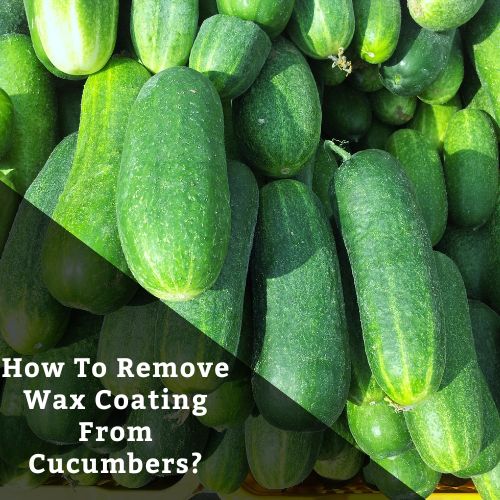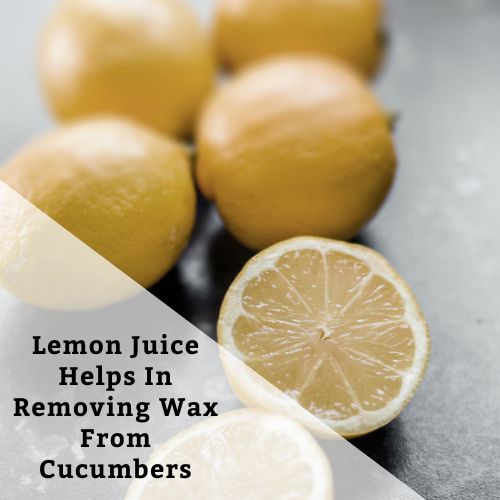How To Remove Wax Coating From Cucumbers?
Vegetables are an essential part of a healthy and balanced diet, providing us with vital nutrients and contributing to our overall well-being. The diversity of vegetables is astounding, with each variety offering its unique set of flavors, textures, and benefits. Among these, cucumbers hold a special place with their refreshing taste and numerous qualities.
Cucumbers, often celebrated for their high water content, are a hydrating vegetable that can help quench thirst and promote hydration. Their crisp and cool nature makes them an ideal choice during the hot summer months when the body craves refreshing nourishment. But cucumbers are not just water-filled delights; they are also a nutritional powerhouse. Packed with vitamins and minerals like vitamin K, vitamin C, potassium, and magnesium, cucumbers contribute to the body’s overall health and vitality.
Beyond their nutritional value, cucumbers have a unique and intriguing texture. The smooth skin, coupled with a crunchy interior, provides a delightful contrast that is both satisfying and enjoyable. The vibrant green color of cucumbers is visually appealing and evokes a sense of freshness and vitality. When sliced, their round shape reveals a captivating pattern of seeds, adding a touch of intrigue to their aesthetic appeal.
Moreover, cucumbers have a remarkable ability to adapt and complement various culinary creations. They can be sliced and added to salads for a refreshing crunch, pickled to create tangy delights, or blended into chilled soups for a revitalizing treat. Cucumbers’ versatility allows them to enhance the flavor profile of a wide range of dishes, adding a touch of freshness and depth to culinary creations.
While we appreciate the natural beauty of cucumbers, it is worth mentioning that they are sometimes coated with a thin layer of wax to preserve their freshness and appearance. This wax serves as a protective barrier, preventing moisture loss and maintaining the cucumber’s natural texture and vibrant color. It is essential to note that the wax used on cucumbers is food-grade and safe for consumption, ensuring that the vegetable remains wholesome and enjoyable.
Why Are My Cucumbers Waxy?

Cucumbers can sometimes have a thin layer of wax on their skin, which is applied for various reasons. Here are a few possible reasons why cucumbers may have a waxy coating:
- Preservation: The wax coating on cucumbers helps to preserve their freshness and extend their shelf life. It acts as a natural barrier, preventing moisture loss and reducing the rate of spoilage. The wax helps cucumbers stay firm and retain their quality for a longer period.
- Protection: The wax coating serves as a protective layer, shielding the cucumber from external contaminants, such as dirt, bacteria, and handling during transportation. It acts as a barrier, reducing the chances of bruising, cuts, and damage to the cucumber’s skin.
- Appearance: The wax gives cucumbers a shiny and appealing appearance, enhancing their visual appeal. A glossy coating makes the cucumbers more attractive to consumers, which can influence their purchasing decisions.
It’s important to note that the wax used on cucumbers is food-grade and considered safe for consumption. It is typically made from natural substances, such as vegetable-based waxes or shellac, which is a resin secreted by the lac bug. These waxes are approved by regulatory agencies and are considered non-toxic.
If you prefer to consume cucumbers without the wax coating, you can remove it by washing the cucumbers thoroughly under running water while gently rubbing the skin with your hands or using a vegetable brush. This should help remove most of the wax, although some residue may remain.
Remember, the wax on cucumbers is primarily there to protect and enhance the quality of the vegetable. So, whether you choose to enjoy them with or without the wax, rest assured that cucumbers remain a nutritious and refreshing addition to your diet.
How To Remove Wax Coating From Cucumbers?
While the wax coating on cucumbers is generally safe for consumption, if you prefer to remove it, here are ten methods you can try:
Warm water soak:
Fill a bowl or sink with warm water and let the cucumbers soak for a few minutes. Then, scrub the skin gently with a vegetable brush to remove the wax.
Vinegar rinse:
Create a mixture of equal parts water and white vinegar. Soak the cucumbers in the vinegar solution for a few minutes, then scrub and rinse them under running water.
Lemon juice rub:

Cut a lemon in half and rub the cut side on the cucumber’s skin. The acidity of the lemon juice can help dissolve the wax. Rinse the cucumber thoroughly afterward.
Baking soda paste:
Make a paste by mixing baking soda with water. Apply the paste to the cucumber’s skin and gently scrub. Rinse off the paste and wax residue with water.
Vegetable peeler:
If you don’t mind peeling the cucumber, you can use a vegetable peeler to remove the wax-coated skin. Ensure that you wash the cucumber before peeling.
Boiling water dip:
Dip the cucumbers briefly into boiling water, then immediately transfer them to a bowl of cold water. The hot water can soften the wax, making it easier to rub off.
Steam treatment:
Place the cucumbers in a steamer basket and steam them for a few minutes. The steam can help soften the wax, making it easier to remove with gentle rubbing.
Rubbing alcohol:
Moisten a cloth or paper towel with rubbing alcohol and gently rub the cucumber’s skin. This can help dissolve the wax. Rinse the cucumber thoroughly afterward.
Commercial produce wash:
Look for a produce wash specifically designed to remove wax from fruits and vegetables. Follow the instructions on the product for effective wax removal.
Unwaxed or organic cucumbers:
If removing wax is a top priority, opt for unwaxed cucumbers or organic varieties that do not have a wax coating to begin with.
Remember to rinse the cucumbers thoroughly after using any of these methods to ensure they are free from any residue or cleaning agents.
Are all cucumbers waxed?
No, not all cucumbers are waxed. The application of wax on cucumbers can vary depending on factors such as the country of origin, the specific variety of cucumber, and the intended market. While many conventionally grown cucumbers may have a wax coating, there are also unwaxed options available.
Conventionally grown cucumbers, especially those that undergo long-distance transportation or are intended for an extended shelf life, are more likely to have a wax coating. The wax helps to preserve the cucumber’s freshness, prevent moisture loss, and enhance its appearance.
On the other hand, certain types of cucumbers, such as English or hothouse cucumbers, are less likely to be waxed. These cucumbers often have a thinner skin and are typically sold unwaxed. Additionally, organic cucumbers, as mentioned earlier, are not treated with synthetic waxes or coatings.
When purchasing cucumbers, it’s always a good idea to check the labeling or inquire with the retailer or farmer to determine whether they are waxed or unwaxed. If you prefer to avoid waxed cucumbers, you can opt for unwaxed varieties or choose organic cucumbers, which generally do not have a wax coating.
Regardless of whether cucumbers are waxed or unwaxed, it’s essential to wash them thoroughly under running water before consumption to remove any potential residues, dirt, or contaminants.
Will vinegar and baking soda remove wax?
Vinegar and baking soda can be used as a combination to help remove wax from certain surfaces, but their effectiveness may vary depending on the type of wax and the specific surface. However, when it comes to removing wax from cucumbers, the use of vinegar and baking soda is not recommended.
Cucumbers have delicate skin, and using vinegar and baking soda may cause unnecessary damage or affect their texture and taste. While vinegar can help break down some types of residues, including certain waxes, it may not be as effective on the wax coating found on cucumbers.
To remove wax from cucumbers, the simple process of thorough washing and scrubbing with water and a vegetable brush or gentle rubbing with a cloth or sponge, as mentioned earlier, is generally sufficient.
If you are concerned about wax residue on your cucumbers, opting for unwaxed or organic cucumbers is a better solution. These varieties are typically not treated with wax, reducing the need for wax removal altogether.
Remember, it’s important to wash all fruits and vegetables, including cucumbers, before consumption to remove any potential contaminants, regardless of whether they have a wax coating or not.